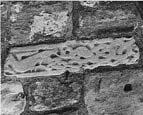Select a site alphabetically from the choices shown in the box below. Alternatively, browse sculptural examples using the Forward/Back buttons.
Chapters for this volume, along with copies of original in-text images, are available here.
Object type: Part of cross-shaft [1]
Measurements: Unobtainable
Stone type: Unobtainable
Plate numbers in printed volume: Pl. 16.76
Corpus volume reference: Vol 1 p. 50
(There may be more views or larger images available for this item. Click on the thumbnail image to view.)
Only one carved face is visible. Part of a moulding which may have been originally a double roll moulding survives. It encloses what appears to be a composition of interlinked birds. At the top one bird quite clearly has a long gull-like beak and round eye. Its head is bent forward on to its chest. One angular wing is raised above its back, and another lies against its body. One leg ends in a three-clawed foot; the other is gripped in the beak of the bird behind. Its tail extends into a wide flat interlace. The bird behind is less decipherable but its tail seems to interlace with the other's.
Compositions of interlinked birds are rare in Anglo-Saxon sculpture, and this is not like the only other one from Northumbria – that at Aberlady, East Lothian. The worn condition of this stone may give a distorted impression of the carving. However, it is plausibly derived from bird compositions such as are found in the Lindisfarne and Lichfield Gospels. Other stones from Billingham (nos. 12 and 13) demonstrate parallels with works, both in manuscripts and sculpture, from other early monastic centres. However, the style of this carving is so widespread that it could, like Woodhorn (no. 1), be a late revival of Hiberno-Saxon motifs (Introduction, p. 32).



